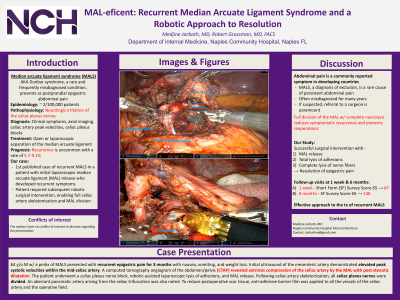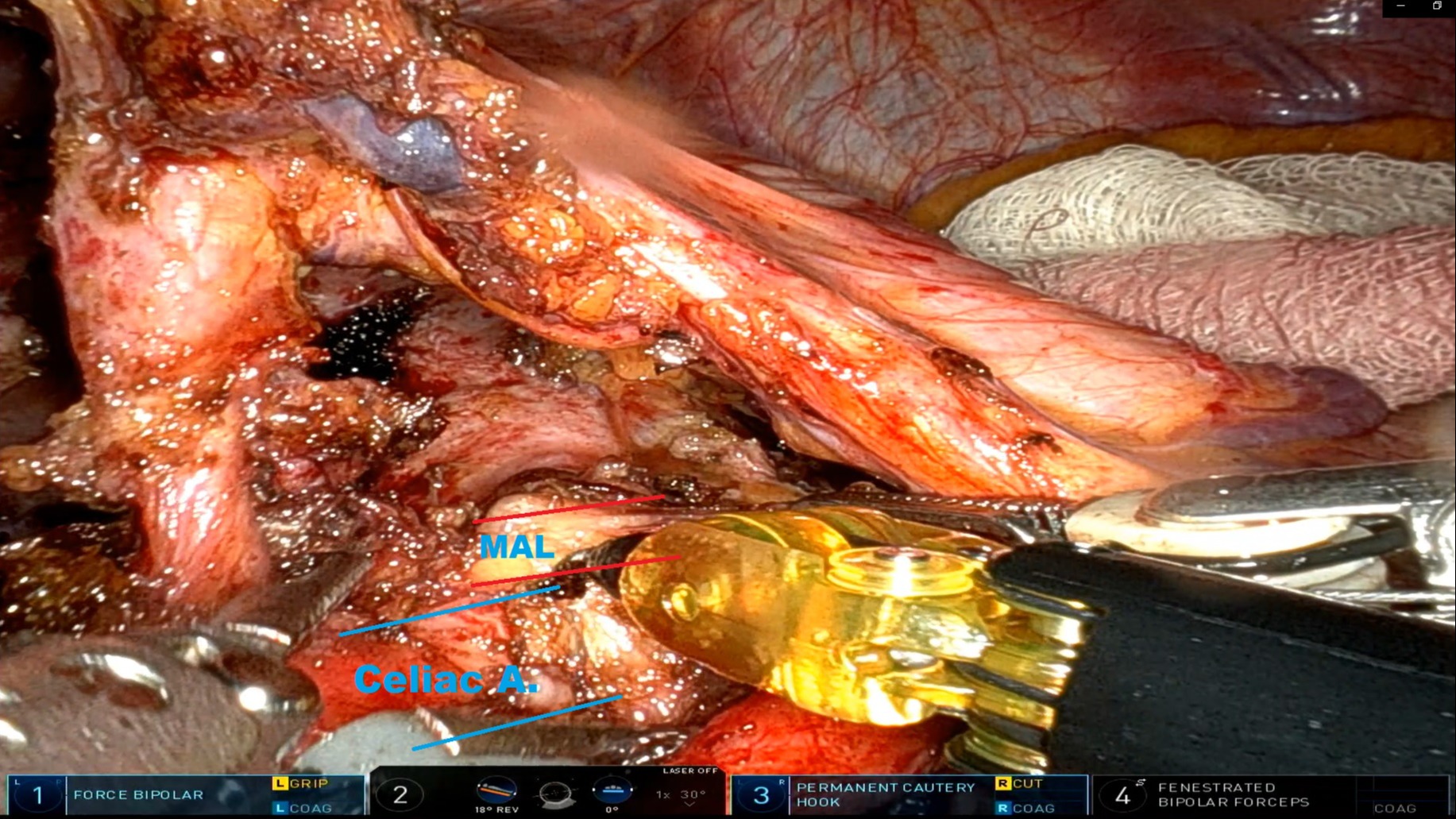Monday Poster Session
Category: Stomach
P2838 - MAL-Eficent: Recurrent Median Arcuate Ligament Syndrome and a Robotic Approach to Resolution
Monday, October 23, 2023
10:30 AM - 4:15 PM PT
Location: Exhibit Hall

Has Audio

Medjine Jarbath, MD
NCH Healthcare System
Naples, FL
Presenting Author(s)
Medjine Jarbath, MD, Robert Grossman, MD
NCH Healthcare System, Naples, FL
Introduction: Median arcuate ligament syndrome (MALS), also known as Dunbar syndrome, is a rare and frequently misdiagnosed condition that presents as postprandial epigastric abdominal pain. Affecting approximately 2/100,000 patients, it is thought to result from neurologic irritation of the celiac plexus nerves. MALS is diagnosed via clinical symptoms, axial imaging, celiac artery peak velocities, and celiac plexus blocks. Although MALS recurrence is uncommon, with a 5.7-9.1% recurrence rate, treating recurrent cases poses a challenge. We report the first published case of recurrent MALS in a 64-year-old male who initially underwent laparoscopic median arcuate ligament (MAL) release but developed recurrent symptoms. The patient required subsequent robotic surgical intervention, enabling full celiac artery skeletonization and MAL division.
Case Description/Methods: A 64 year-old male with a past medical history of MALS presented with recurrent epigastric pain for 3 months with nausea, vomiting, and weight loss. Initial ultrasound of the mesenteric artery demonstrated elevated peak systolic velocities within the mid-celiac artery. A computed tomography angiogram of the abdomen/pelvis revealed extrinsic compression of the celiac artery by the MAL with post-stenotic dilatation. The patient underwent a celiac plexus nerve block, robotic-assisted laparoscopic lysis of adhesions, and MAL release. Following celiac artery skeletonization, all celiac plexus nerves were divided. An aberrant pancreatic artery arising from the celiac trifurcation was also noted. To reduce postoperative scar tissue, anti-adhesive barrier film was applied to all the vessels of the celiac artery and the operative field.
Discussion: Abdominal pain is a commonly reported symptom in developing countries. While MALS is a rare cause of persistent abdominal pain, it is a diagnosis of exclusion where other common gastrointestinal conditions must be ruled out. Additionally, it is often misdiagnosed for many years. If MALS is suspected, referral to a surgeon is paramount, as full division of the MAL with complete neurolysis will reduce symptomatic recurrence and prevent reoperations. After successful surgical intervention with MAL release, total lysis of adhesions and nerve fibers, our patient reported resolution of epigastric pain. Follow-up visits at 1 week and 6 months showed improvement in his Short Form Survey score from 65 to 87 and 140, respectively. We hope this report will provide an effective approach to the treatment of recurrent MALS.

Disclosures:
Medjine Jarbath, MD, Robert Grossman, MD. P2838 - MAL-Eficent: Recurrent Median Arcuate Ligament Syndrome and a Robotic Approach to Resolution, ACG 2023 Annual Scientific Meeting Abstracts. Vancouver, BC, Canada: American College of Gastroenterology.
NCH Healthcare System, Naples, FL
Introduction: Median arcuate ligament syndrome (MALS), also known as Dunbar syndrome, is a rare and frequently misdiagnosed condition that presents as postprandial epigastric abdominal pain. Affecting approximately 2/100,000 patients, it is thought to result from neurologic irritation of the celiac plexus nerves. MALS is diagnosed via clinical symptoms, axial imaging, celiac artery peak velocities, and celiac plexus blocks. Although MALS recurrence is uncommon, with a 5.7-9.1% recurrence rate, treating recurrent cases poses a challenge. We report the first published case of recurrent MALS in a 64-year-old male who initially underwent laparoscopic median arcuate ligament (MAL) release but developed recurrent symptoms. The patient required subsequent robotic surgical intervention, enabling full celiac artery skeletonization and MAL division.
Case Description/Methods: A 64 year-old male with a past medical history of MALS presented with recurrent epigastric pain for 3 months with nausea, vomiting, and weight loss. Initial ultrasound of the mesenteric artery demonstrated elevated peak systolic velocities within the mid-celiac artery. A computed tomography angiogram of the abdomen/pelvis revealed extrinsic compression of the celiac artery by the MAL with post-stenotic dilatation. The patient underwent a celiac plexus nerve block, robotic-assisted laparoscopic lysis of adhesions, and MAL release. Following celiac artery skeletonization, all celiac plexus nerves were divided. An aberrant pancreatic artery arising from the celiac trifurcation was also noted. To reduce postoperative scar tissue, anti-adhesive barrier film was applied to all the vessels of the celiac artery and the operative field.
Discussion: Abdominal pain is a commonly reported symptom in developing countries. While MALS is a rare cause of persistent abdominal pain, it is a diagnosis of exclusion where other common gastrointestinal conditions must be ruled out. Additionally, it is often misdiagnosed for many years. If MALS is suspected, referral to a surgeon is paramount, as full division of the MAL with complete neurolysis will reduce symptomatic recurrence and prevent reoperations. After successful surgical intervention with MAL release, total lysis of adhesions and nerve fibers, our patient reported resolution of epigastric pain. Follow-up visits at 1 week and 6 months showed improvement in his Short Form Survey score from 65 to 87 and 140, respectively. We hope this report will provide an effective approach to the treatment of recurrent MALS.

Figure: A robotic view of the celiac artery and the overlying median arcuate ligament (MAL)
Disclosures:
Medjine Jarbath indicated no relevant financial relationships.
Robert Grossman indicated no relevant financial relationships.
Medjine Jarbath, MD, Robert Grossman, MD. P2838 - MAL-Eficent: Recurrent Median Arcuate Ligament Syndrome and a Robotic Approach to Resolution, ACG 2023 Annual Scientific Meeting Abstracts. Vancouver, BC, Canada: American College of Gastroenterology.
